What is a perfume?
A perfume is an odorous substance often complex, i.e. made of several components. The complexity of a perfume is remarkable by the difficulty we have to qualify a scent. When a perfume is released into the air, the top note is the first to be released, the one we smell first, then as time goes by, some substances (the most volatile) evaporate and others remain: the middle notes. After an even longer time, only the lingering notes remain: the base notes. Here is a summary of the different types of natural olfactory notes:
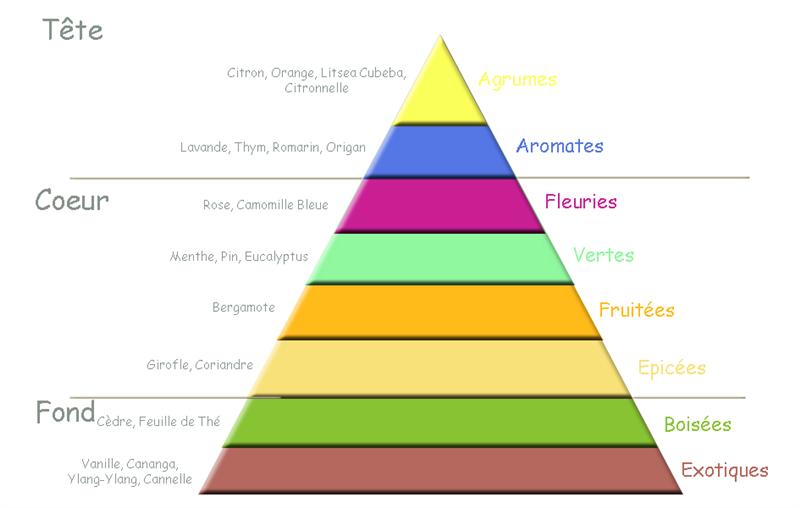
Thus, by definition, certain notes can only be top notes because they take over immediately (citrus). In order to create olfactory notes, it is necessary to know the physiological functioning of their perception.
What is olfaction?
The sense of smell is fascinating because of its sensitivity and its ability to distinguish a multitude of odorous molecules. Science is far from knowing everything about the olfactory system but tries to better understand it every day through research. The nose allows humans to recognize about 10,000 different odors for a trained professional at very low concentrations and to distinguish good odors from bad ones. This sense contributes to the appreciation of the hedonic functions of many common products such as laundry detergent, shower gel… Today all products are scented and it is a very important purchase criterion for the consumer.
What biological phenomena are at the root of olfaction?
Physiology of olfaction
The human nose is a more sensitive detector of odorous molecules than most known physicochemical sensors. Nevertheless, some animals have a much finer sense of smell than human beings.
Olfactory perception arises from the interaction between volatile chemical compounds and millions of receptor cells located in the upper nasal cavity within a mucous membrane called the olfactory epithelium. This epithelium communicates directly with the olfactory bulb located in the brain through the extensions of the olfactory receptor cells.
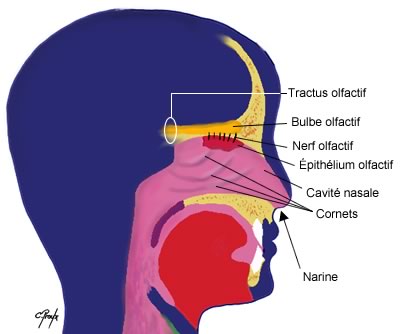
These cells are olfactory neurons which carry a tuft of 20 to 30 cilia between 50 and 200µm in length and bathed in aqueous mucus (see zoom of the figure below). They are still called neuroreceptors, sensory cells or simply receptor cells.
The mucus contains many proteins and ensures in particular the functions of immune defense, permanent washing of the nasal mucosa… The olfactory epithelium is made up of three types of cells :
- the support or interstitial cells which have the role of supporting the tissue network,
- the olfactory cells which are neurons (about 10 millions),
- the basal cells. The latter give the olfactory system the property to divide to give birth to new neuroreceptors.
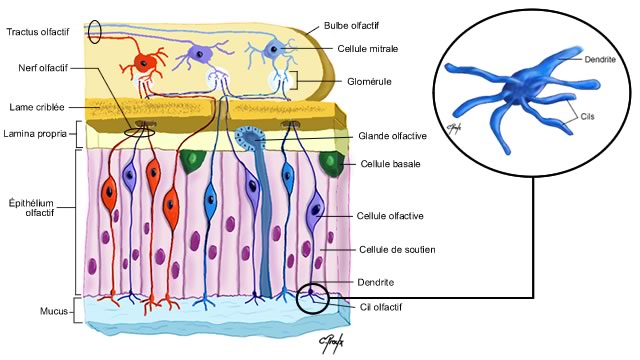
The cilia of the neuroreceptors have a membrane made up of numerous receptor proteins capable of recognizing multitudes of odorous substances. Each olfactory neuron has a single type of receptor. Each receptor responds to a small group of molecules and each molecule can bind to several types of receptors.
The olfactory neurons live between 30 and 120 days and then die. They are then replaced by new neurons from the basal cells.
The diagram below illustrates the previous statement and shows that if a person does not have the special receptor to the molecule then he will not feel its perfume: this is why some people are very sensitive to certain perfumes or feel nuances and subtle perfumes that other people do not feel…
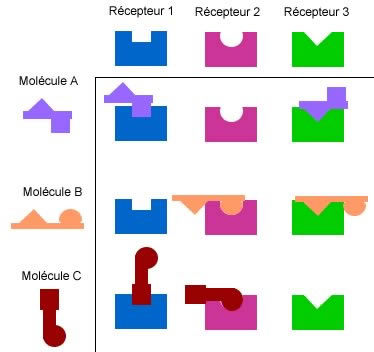
When the odorant molecules come into contact with the membrane of the cilia of the neurons, chemical and electrical reactions are produced. These reactions are transcribed into nerve impulses which are transmitted to the brain by the axons (extension of a neuron) of the receptor cells, which group together to form the olfactory nerve. It is the olfactory bulb that then receives the nerve messages in the brain and transmits them to the olfactory cortex where these messages are associated with emotional values. Imaging studies have shown that many areas of the brain are activated during olfactory stimuli such as the thalamus, amygdala, hypothalamus, hippocampus, and different cortices. It turns out that nerve impulses reaching the hippocampus and amygdala induce the formation of memories and emotions. Thus, olfactory information is always associated with a sensory and emotional context. This is why certain smells can make us nostalgic.
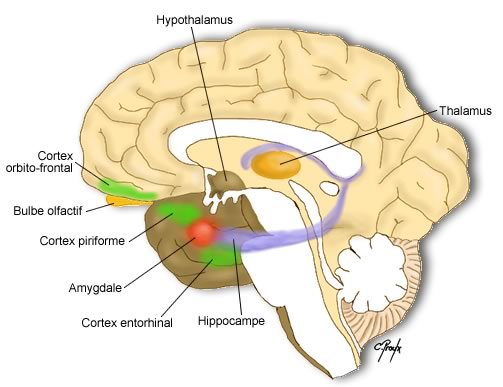
Note that if the odorous substance is not soluble in the aqueous nasal mucus containing the olfactory receptors, then it appears odorless. Thus, if certain molecules do not have an odor, it is perhaps simply that they have not reached their olfactory target.
Molecule and Odor
Perfume chemists have always tried to link the odor of a compound to its molecular structure without really being able to rely on fundamental knowledge. For a molecule to smell, it must have a moderate molecular weight (volatility), low polarity, some solubility in water, lipophilicity and high vapor pressure. No particular reactivity or specific functional groups are required, but these often generate particular odors. (Example of Thiols S-H group with an easily recognizable odor).
Some qualitative studies have certainly shown that molecules with similar structures give off a similar odor, but this is not general and a multitude of exceptions prove it. We notice in particular that on the contrary very different molecular structures can present close odors.
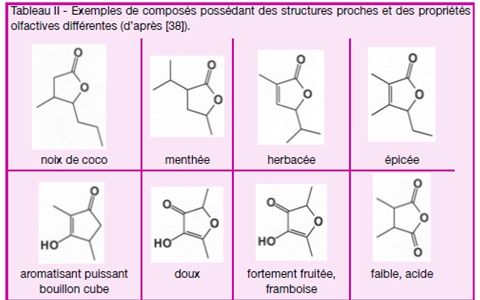
Here are molecules that are chemically close and yet the olfactory names that characterize them are radically different. Several theories have been developed but it turns out that today it is impossible to predict the smell of a molecule based on its chemical structure with a satisfactory margin of error. This is mainly due to the fact that the appreciation of the odor remains carried out by the human being and thus endowed with an incredible subjectivity.
Let’s see below two enantiomers: the first one has a very unpleasant smell while the other one has a fresh and pleasant smell. Only a small change can completely reverse the information.
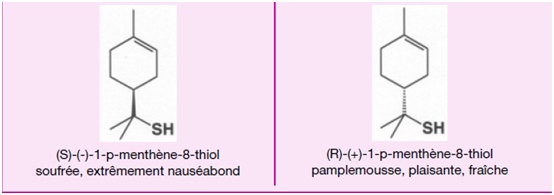
Let’s also talk about the concentration of a fragrance molecule: some have such a powerful smell that they can be detected by humans at very small quantities.
![La pyrrolidino[1,2-e]-4H-2,4-diméthyl-1,3,5-dithiazine](https://salveco.fr/wp-content/uploads/2023/01/PYROLIDINOL.jpg)
Both enantiomers of pyrrolidino[1,2-e]-4H-2,4-dimethyl-1,3,5-dithiazine can be detected by the human sense of smell at 10-18 g/L of water. That is 4µg in an Olympic size swimming pool.
Subjectivity of olfaction
Of course, olfaction is a subjective domain and this for several reasons. The previous evocation of the association of a smell with an emotion will be different for each person: good or bad memory. Unconsciously, the person will bring in this element in his appreciation, even if the perfume itself does not displease him. Moreover, it is necessary to know that everyone does not have the same receptors, nor the same number. This difference in sensitivity between each person means that there will be very fine nuances that one tester will be able to detect and that another will not feel at all: between the most sensitive and the least sensitive individuals, a factor of 1000 is observed. Of course, a trained nose is more efficient than an untrained one, but that is not all. The human nose has a particularly well-developed capacity to detect odors, which makes it much easier for this person to nuance his or her judgment, to separate the different scented components, to detect both top and bottom notes…
For a given smell, the images generated inside our brain are not perceptible by another person. This explains why it is difficult to put a precise name on certain smells. We have to learn how to talk to each other when we talk about smells and aromas. We can do this gradually by building a vocabulary based on common olfactory experiences. Sometimes certain scents can be perceived in several ways depending on the olfactory receptors that each person has. The most classic example is the perception of butyric acid. About 6% of individuals recognize this odor as close to the smell of vinegar, while the rest of the population considers that this compound has a nauseating smell reminiscent of Camembert cheese. It should also be noted that a human nose can momentarily lose its olfactory capacities: a prolonged exposure to the same odor or to a too important concentration of it leads to a saturation of the olfactory receptors and the disappearance of the information.
Olfactometry
The term “Olfactometry” refers to both the measurement of odors and the measurement of a subject’s olfactory abilities. In each case, a sensor and an odor are brought together. Either a known stimulus is used to characterize the sensor or the opposite. Three main parameters qualify an odor:
- A quantitative parameter: its intensity, its strength
- A qualitative parameter: description in relation to an odorous object or a reference
- A temporal parameter: evolution in time of the intensity or quality (persistence, rancidity…)
The tools used to qualify all of this are physico-chemical analysis and a trained “nose jury”. New technologies such as electronic “noses” are being developed more and more.
- The physico-chemical analysis highlights the presence of chemical compounds in the air and a table of olfactory properties is used to characterize the resulting odor. The gas chromatography allows to identify the molecules entering the composition of an odor as well as their dosage, in order to duplicate this assembly.
Disadvantages: the sensor does not detect everything, and quantities that are too minute are not taken into account. Moreover, the olfaction of a mixture is often different from the components taken separately.
- The electronic “nose”: less efficient than the human being, it is developed within the framework of quality control in the food industry or research and development for perfumers. Its main quality lies in the inability to saturate olfactory receptors, as often happens in humans.
- The jury of “noses”: direct evaluation of the smell by the human being. Composed of four to sixteen “noses”, this jury must evaluate the intensity, the composition, classify and qualify the perfumes. An AFNOR standard is provided for this purpose.
